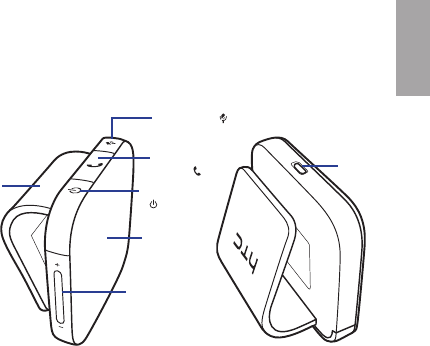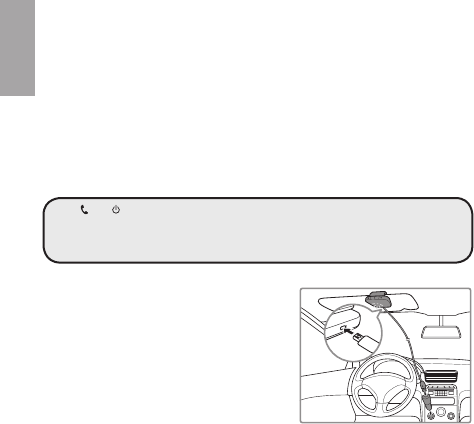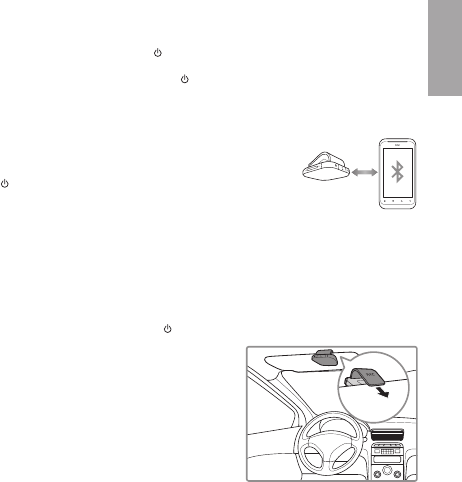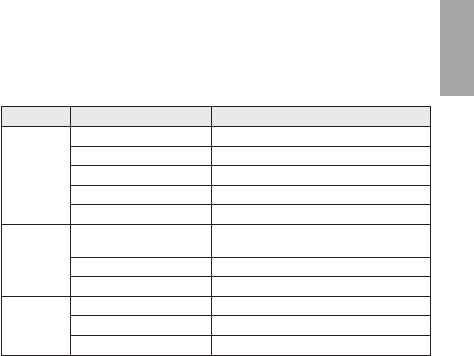Users Manual

HTC BS C100 Bluetooth® Car Speaker
User Guide
hp://www.htc.com/www/support/warranty.html

1
English
Overview
Thank you for purchasing the HTC BS C100 Bluetooth® Car Speaker. We hope you enjoy it! This
User Guide will get you started and ready to make the most of your car speaker.
About your HTC BS C100
What your car speaker can do
Your HTC BS C100 lets you do all this:
Answer calls•
End calls•
Reject calls•
Last number redialling•
Mute•
Voice search•
Volume buon
Mute buon ( )
Mul-funcon
buon ( )USB
connector
Visor clip Power buon
()
LED
indicator

2
English
Specifications
Talk me up to• x hours/standby me up to xxx hours
Rechargeable baery with charging opon from car charger or PC via USB cable•
LED light for status and baery indicator•
Qualied for Bluetooth Specicaon version 2.0 + EDR (enhanced data rate), supporng •
Headset and Hands-free Proles.
e-SCO for enhanced audio quality•
Size: • xxmm (L) x xxmm (W) x xxmm (T)
Weight: • xx grams
Getting Started
The HTC BS C100 is easy to operate. On the inial setup, do the following:
1. Charge your car speaker
Before using HTC BS C100 for the rst me, you need
to charge it by the supplied micro USB cable with
your car charger for about 8 hours. Normal charge is
approximately 3.5 hours.
While charging the LED indicator lights orange. It •
turns green when the baery is fully charged.
Note:
HTC BS C100 is funconal while charging.
The and buons on the car speaker performs dierent funcons depending on
how long you press it.
- Press: Less than 1.5 seconds
- Long press: more than 1.5 seconds

3
English
2. Power ON/OFF
To turn on the speaker, • press the buon. The LED indicator lights green (for 3 seconds)
indicates the speaker is turned on.
To turn o the speaker, • press again the buon. The LED indicator lights orange (for 3
seconds) indicates the speaker is turned o.
3. Pairing and connect
Bluetooth car speaker needs to be paired to your mobile phone before it can be used.
1. Make sure the car speaker is turned o and turn o any
Bluetooth devices previously paired with your car speaker.
2. Turn on the Bluetooth feature on your phone and long press the
buon to turn on the car speaker. The LED indicator displays
an alternang green and orange light, this indicates the car
speaker is in pairing mode.
3. Set your mobile phone to search for Bluetooth devices, and select HTC BS C100 from
the search results on your mobile phone.
4. The car speaker will play an audible tone along a steady green light to indicate the pairing is
successful and devices are connected.
Reconnecng the car speaker to mobile phone
a. When the car speaker is turned o then on again. It will aempt to re-establish the
connecon to your mobile phone automacally.
b. Alternavely, you can long press the buon to re-establish the connecon manually.
4. Test your connecon
To test connecon to your phone, do the following:
1. Place the car speaker onto your visor.
2. Make a call from your mobile phone. If your mobile
phone and car speaker are successfully connected,
you can hear the ringing tone on the car speaker.
3. Adjust the volume level (if necessary).

4
English
Reseng the pairing devices
Long press the XX buon to clear all pairing informaon stored in HTC BS C100. The car speaker
will automacally turn o aer approx. 20 seconds.
How to…
Making a call
Use your mobile phone in the normal way to make a call.
Answering a call
Press the buon to answer the call.
Last number redial
Press the buon twice to acve last number redial.
Ending a call
During a call, press the buon to hang up. If the other person hangs up rst, then the call will
be ended automacally.
Rejecng a call
Long press or press the buon to reject the incoming call.
Mung a call
During a call, press the buon and the car speaker will mute. To cancel mute, press the
buon again.
Note:
If the microphone is muted, the prompt tone will be played back for every 5 seconds.
Making a voice dial call
Long press the buon and wait for the voice prompt.
Adjusng sound and volume
To increase the volume, press the Volume up (+) buon.•
To decrease the volume, press the Volume up (-) buon.•

5
English
Baery
When the baery needs charging, the LED indicator lights orange. If you do not charge the car
speaker, it automacally turns o.
What the LED indicator mean
Event LED color Status
General
Green (Solid for 3 seconds) Car speaker is turned on
Orange (Solid for 3 seconds) Car speaker is turned o
Orange (Solid, connuous) Baery is low
Green (Blink) Incoming call
Green (Solid, connuous) Call in progress
Pairing
Alternang Green and
Orange (Blink)
Pairing mode
Green (Solid, connuous) Devices are successfully paired
Orange (Blink)Devices are unsuccessfully paired
Charging
Orange (Solid, connuous) Baery charging
Orange (Blink) Charging error
Green (Solid, connuous) Charging complete
Troubleshooting & FAQ
I hear crackling noises
Bluetooth is a radio technology, which means it is sensive to objects between the car •
speaker and the connected device. It is designed for the car speaker and the connected
device to be used within 33 feet (10 meters) of each other, with no major objects in the way
(walls, etc.).

6
English
I cannot hear anything from my car speaker
Increase the volume in the car speaker.•
Ensure that the car speaker is paired to your mobile phone.•
Make sure your phone is connected to the car speaker.•
I am having pairing problems
You may have deleted your car speaker pairing connecon in your mobile phone.•
Follow the pairing instrucons.•
I want to reset the car speaker
It is possible to reset and test the car speaker by ’long press’ the XX buon unl the alternang
green and orange lights are o. The car speaker will automacally turn o aer approx. 20
seconds. The next me you power on, the car speaker will go into pairing mode as the rst me
you powered your new HTC BS C100 on.
Will the HTC BS C100 work with other Bluetooth equipment?
The HTC BS C100 is designed to work with Bluetooth mobile phones. It can also work with other
Bluetooth devices that are compliant with Bluetooth version 1.1 or higher and support hands-
free and/or advance audio distribuon prole.
I cannot use Reject call, Redial, or Voice Dialling feature
These features are dependent on the ability of your mobile phone to support a hands-free
prole. Even if the handsfree prole is implemented reject call, call hold and voice dialling are
oponal features which are not supported by all devices. Please consult your device manual
for details.
The mobile phone is not connected to my car speaker in me to answer an incoming call
If the car speaker is o and is turned on when a call is incoming, the mobile phone and
car speaker might not connect in me for the call to be answered. In order to avoid such
inconveniences please keep the car speaker on, in range and connected.

7
English
Taking care of your car speaker
Always store the • HTC BS C100 with the power o and safely protected.
Avoid storage at extreme temperatures (above 45°C/113°F – including direct sunlight – or •
below -10°C/14°F). This can shorten baery life and may aect operaon.
High temperatures may also degrade performance. Do not expose the • HTC BS C100 to rain
or other liquids.
WARNING!
Car speakers are capable of delivering sounds at loud volumes and high pitched tones. Exposure
to such sounds can result in permanent hearing loss damage. The volume level may vary based
on condions such as the phone you are using, its recepon and volume sengs, and the
environment. Please read the safety guidelines below prior to using this car speaker.
Safety guidelines
1. Prior to using this product follow these steps:
Before using the car speaker, turn the volume control to its lowest level, •
Make a test call, and then •
Slowly adjust the volume control to a comfortable level.•
2. During the use of this product
Keep the volume at the lowest level possible and avoid using the car speaker in noisy •
environments where you may be inclined to turn up the volume;
If increased volume is necessary, adjust the volume control slowly;•
3. Keep out of reach of children
The plasc bags the product and its parts are wrapped in are not toys for children. The bags
themselves or the many small parts they contain may cause choking if ingested.
4. Never try to dismantle the product yourself
None of the internal components can be replaced or repaired by users. Only authorised dealers
or service centres may open the product. If any parts of your product require replacement for
any reason, including normal wear and tear or breakage, contact your dealer.

8
English
5. ACA TS028 – Ignion of ammable atmospheres
Do not use the car speaker in environments where there is a danger of ignion of ammable
gases.
Certification
CE
This product is CE marked according to the provisions of the R & TTE Direcve (99/5/EC). Hereby,
HTC, declares that this product is in compliance with the essenal requirements and other
relevant provisions of Direcve 1999/5/EC.
For further informaon please consult hp://www.HTC.com
Within the EU this device is intended to be used in Austria, Belgium, Bulgaria, Cyprus, Czech
Republic, Denmark, Estonia, Finland, France, Germany, Greece, Hungary, Ireland, Italy, Latvia,
Lithuania, Luxembourg, Malta, Poland, Portugal, Romania, Slovakia, Slovenia, Spain, Sweden,
The Netherlands, United Kingdom, and within EFTA in Iceland, Norway and Switzerland.
Bluetooth
The Bluetooth® word mark and logos are owned by the Bluetooth SIG, Inc. and any use of such
marks by HTC is under license. Other trademarks and trade names are those of their respecve
owners.
Compability for a Beer Environment
The Direcve on Waste Electrical and Electronic Equipment (WEEE), which entered into force
as European law on the 13th February 2003, resulted in a major change in the treatment of
electrical equipment at end-of-life.
The purpose of this direcve is, as a priority, the prevenon of WEEE, and in addion, to
promote the reuse, recycling and other forms of recovery of such waste so as to reduce disposal.
The WEEE logo on the product or on its box indicates that this product must not be
disposed of or dumped with your other household waste. You are liable to dispose of all your
electronic or electrical waste equipment by relocang over to the specied collecon point for
recycling of such hazardous waste. Isolated collecon and proper recovery of your electronic
and electrical waste equipment at the me of disposal will allow us to help conserving natural
resources. Moreover, proper recycling of the electronic and electrical waste equipment will

9
English
ensure safety of human health and environment. For more informaon about electronic and
electrical waste equipment disposal, recovery, and collecon points, please contact your local
city centre, household waste disposal service, shop from where you purchased the equipment,
or manufacturer of the equipment.
FCC Regulaons:
This device complies with part 15 of the FCC Rules. Operaon is subject to the following two
condions: (1) This device may not cause harmful interference, and (2) this device must accept
any interference received, including interference that may cause undesired operaon.
This device has been tested and found to comply with the limits for a Class B digital device,
pursuant to Part 15 of the FCC Rules. These limits are designed to provide reasonable protecon
against harmful interference in a residenal installaon. This equipment generates, uses and
can radiated radio frequency energy and, if not installed and used in accordance with the
instrucons, may cause harmful interference to radio communicaons. However, there is no
guarantee that interference will not occur in a parcular installaon If this equipment does
cause harmful interference to radio or television recepon, which can be determined by turning
the equipment o and on, the user is encouraged to try to correct the interference by one or
more of the following measures:
- Reorient or relocate the receiving antenna.
- Increase the separaon between the equipment and receiver.
- Connect the equipment into an outlet on a circuit dierent from that to which the receiver is
connected.
- Consult the dealer or an experienced radio/TV technician for help.
Changes or modicaons not expressly approved by the party responsible for compliance could
void the user‘s authority to operate the equipment.
The antenna(s) used for this transmier must not be co-located or operang in conjuncon with
any other antenna or transmier.

10
English
RF Exposure Informaon
This device meets the government’s requirements for exposure to radio waves.
This device is designed and manufactured not to exceed the emission limits for exposure
to radio frequency (RF) energy set by the Federal Communicaons Commission of the U.S.
Government.
This device complies with FCC radiaon exposure limits set forth for an uncontrolled
environment.
RoHS Compliance
This product is in compliance with Direcve 2002/95/EC of the European Parliament and of
the Council of 27 January 2003, on the restricon of the use of certain hazardous substances in
electrical and electronic equipment (RoHS) and its amendments.
Administrative Rules for Low-power Radio-Frequency Devices
Arcle 12
For those low-power radio-frequency devices that have already received a type- approval,
companies, business units or users should not change its frequencies, increase its power or
change its original features and funcons.
Arcle 14
The operaon of the low-power radio-frequency devices is subject to the condions that no
harmful interference is caused to aviaon safety and authorized radio staon; and if interference
is caused, the user must stop operang the device immediately and can’t re-operate it unl the
harmful interference is clear. The authorized radio staon means a radio-communicaon service
operang in accordance with COMMUNICATION ACT.
The operaon of the low-power radio-frequency devices is subject to the interference caused by
the operaon of an authorized radio staon, by another intenonal or unintenonal radiator, by
industrial, scienc and medical radiate equipment.

11
English
Glossary
1. Bluetooth is a radio technology that connects devices, such as mobile phones and car
speaker, without wires or cords over a short distance (approx. 10 meters/33 feet). Bluetooth
is safe to use. It is secure too, so once a connecon has been made no-one can listen in and
there is no interference from other Bluetooth devices either. Get more informaon at www.
bluetooth.com.
2. Bluetooth proles are the dierent ways that Bluetooth devices communicate with other
devices. Bluetooth phones support the headset prole, the hands-free prole or both. In
order to support a certain prole, a phone manufacturer must implement certain mandatory
features within the phone’s soware.
3. Pairing creates a unique and encrypted link between two Bluetooth devices and lets them
communicate with each other. Bluetooth devices will not work if the devices have not been
paired.
4. Standby mode is when the HTC BS C100 is passively waing for a call. When you ‘end’ a call
on your mobile phone, the car speaker goes into standby mode.
© 2011 HTC. All rights reserved. All other trademarks included herein are the property of their
respecve owners. The Bluetooth® word mark and logos are owned by the Bluetooth SIG, Inc.
and any use of such marks by HTC is under license.
(Design and specicaons subject to change without noce).